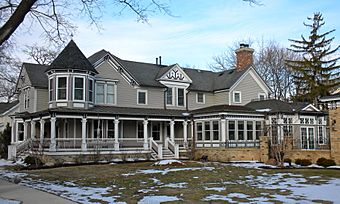Barrington Historic District facts for kids
Quick facts for kids |
|
|
Barrington Historic District
|
|

House in the district in Cook County
|
|
| Location | Roughly bounded by Chicago & Northwestern RR, S. Spring and Grove Sts., E. Hillside and W. Coolidge, and Dundee Aves., Barrington, Illinois |
|---|---|
| Area | 92 acres (37 ha) |
| NRHP reference No. | 86001047 |
| Added to NRHP | May 16, 1986 |
The Barrington Historic District is a special area in Barrington, Illinois. It covers about 92 acres and is full of old, important buildings. This district is mostly a neighborhood with homes. It's found in the southwest part of Barrington.
The district is bordered by the Chicago and Northwestern Railway tracks to the north. Dundee Avenue is to the west. E. Hillside and W. Coolidge Streets are to the south. S. Spring and S. Grove Streets are to the east. Most of this historic area is in Cook County, Illinois. A small part, about one block, is in Lake County, Illinois.
History of Barrington
The very first people to settle in Barrington, Illinois arrived in the 1830s. The areas known as Barrington and Troy Townships were officially set up in 1850. Barrington got its name from a town called Great Barrington, Massachusetts. Many of the early settlers came from there.
A man named Benjamin Felter owned the land where the southern part of the village now stands. In 1854, a railway line, the Chicago and North Western, connected to the area. After this, A. S. Downs bought the land as an investment. Downs then sold it to Robert Campbell. Campbell divided the land into smaller pieces for homes and businesses.
The town grew very quickly. It was officially named Barrington Station in 1863. By 1865, about 300 people lived there. The name was later changed to just Barrington in 1873.
The area that became the historic district was planned like a typical Midwestern town. It had a grid pattern, like a checkerboard. Most of the houses were built from wood. This was because wood was easy to find nearby. Even though the houses have different styles, they look similar because of the wood.
The district shows how towns changed from being rural (countryside) to suburban (near a big city). The Barrington Historic District includes a special building called the Octagon House. It's one of only a few octagon-shaped houses in Illinois. The district was added to the National Register of Historic Places on May 16, 1986. This means it's recognized as an important historical place.
Building Styles
The homes in the Barrington Historic District were mostly built between 1860 and 1930. They show off many different building styles. Some of these styles include American Craftsman, Greek Revival, and Gothic Revival. You can also see Italianate, Neoclassical, and Queen Anne styles. Some homes are also built in simpler, local styles.
Even with all these different looks, the houses share many things in common. Most of them are built partly or fully with wood. Nearly all are one-and-a-half to two stories tall. They are also set back about the same distance from the street.
Almost 80% of the homes in the district are considered "contributing properties." This means they help make the district historically important. These houses show how architecture changed in Barrington over time. Their styles reflect popular building trends in America from 1860 to 1930.




